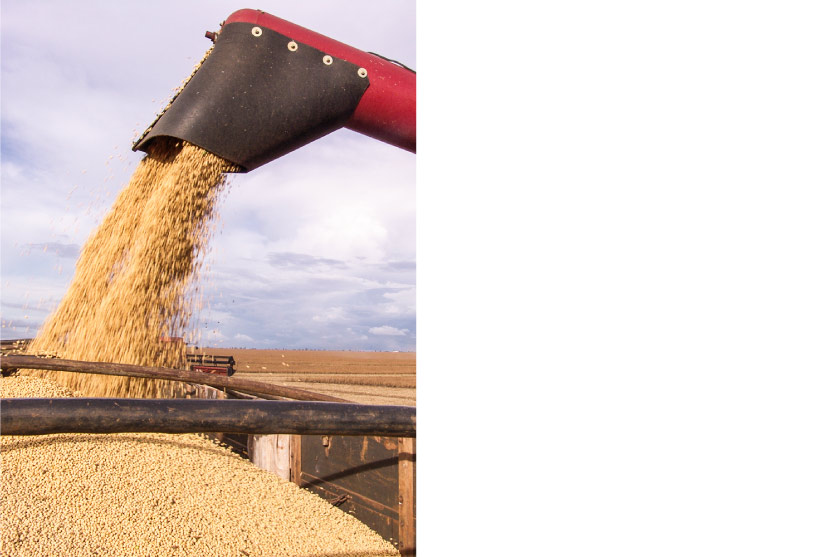First Xtend Soybean Fields Harvested

By John Dietz
Looking back on the crops he harvested, Brian Nadeau says it was a year to remember with the weather and the arrival of Xtend soybeans.
It was early November. Day and night temps were setting records. Fields were saturated, or close to it, but not frozen. It was “great” weather for September, but hardly normal for November.
Still, he was happy with the results of the growing season. It went extremely well.
Nadeau is one of the senior soybean growers in Manitoba. He is one of the first growers in Western Canada to grow soybeans with the Xtend trait. In mid-July, he was extremely happy with the new weed control system and anticipating the harvest.
“I’m hearing it with all varieties. It was just a season for beans,” Nadeau was saying in mid-November. “The harvest went very, very well. We were extremely happy with the yields this year. It was simply amazing.”
Nadeau Seeds Inc., at Fannystelle, is on the western edge of the Red River clay-loam soils. The family has operated a cleaning facility since 1967. This year, Brian put in his 16th crop of soybeans.
“NorthStar Genetics supplied the Xtend seed for two fields,” he says.
One is NSC Starbuck RR2X. Starbuck is rated for 2425 CHU as a mid to long season variety suited to the eastern Prairies.
The other is what was previously NSC EXP 114 RR2X, which has now been named NSC StarCity RR2X. It is the earliest Xtend variety from NorthStar, rated at 2275 CHU. It is due to be named soon.
Both lines have the new Roundup Ready 2 Xtend technology, resistant to both glyphosate and dicamba. Xtend technology now is licensed in Canada and the United States and is entering the market this fall for the first time for commercial production.
There’s reason for excitement among soybean growers, Nadeau says. The new lines of Xtend soybeans, in addition to carrying resistance to both glyphosate and dicamba, carry the latest genetic improvements developed by plant breeders.
“What comes with the technology is better genetics, better yield potential, and better weed control,” Nadeau says.
Harvest bushels
Harvest was delayed and challenging, but Nadeau ended up getting all his beans, and they came off in very, very good shape.
He warns, however, that harvest yield results, the claims and the reality, can be very different.
“The yields this year, for most, were probably the highest I’ve ever heard. This year, the claims are pretty consistently in the high 40s and 50s right across the (Red River) Valley,” he says.
His own contract growers were all claiming yields in the high 50s for Starbuck Xtend soybeans.
“That’s not hauled in. That’s a farmer bushel off his yield monitor, going into the bin. We’ll see what it really is when it crosses our scale in a few weeks,” he says.
Nadeau’s own fields of Xtend beans, after some issues with weather, did very well but he’s not claiming any records. The numbers he reports, however, are solid. The weight of every load in every grain cart is recorded, and makes up the basis for his yield report.
“The NSC Starbuck RR2X beans did yield 46 bushels an acre. We’ve got other varieties that did better,” he says. “The Starbuck had a lot of water, and it had about 80 to 90 acres of hail damage. When we went in there to harvest, yield went down to 30 bushels an acre in those areas. That brings the average yield way down.”
The realistic average yield for Starbuck on his own fields, where it was not hail-damaged, probably was ten bushels more than his weighed, field-average result. Another way he describes the difference is that it took approximately twice as much travel distance, on damaged crop, to pick up the same hopper-load.
The NSC StarCity RR2X did a little better than Starbuck by Nadeau’s record. It also escaped the hail damage.
“The NSC StarCity was a super-nice looking bean. It’s nice and early, and it did 49 bushels an acre,” he says.
XtendiMax system
Along with the two-trait seed, Monsanto is introducing a new herbicide – XtendiMax with VaporGrip Technology herbicide. XtendiMax contains a proprietary formulation of dicamba that controls broadleaf weeds in the Roundup Ready 2 Xtend system in soybeans.
As a system, this sets the stage for managing resistance to glyphosate while enhancing control of weeds such as kochia, wild buckwheat, and Canada thistle.
Nadeau is very cautious with weed control. He applied the pre-emerge XtendiMax at 0.7 liters per acre in 13 gallons of water, with 25 psi and travelling at 8 mph. Wind was about 8 km/h at the start.
“When the wind came up a little, to about 14 km/h, we quit. Where it would be normal to still be spraying, we quit. Those fields stayed whistle-clean for 20 days, for sure. We almost couldn’t find a weed; it was so impressive.
“We did our second application at 0.3 liters per acre. The crop came through, stayed extremely clean – then we got wet. It started to rain and rain. The Xtend is not made to control grasses, but it did a really good job on the buckwheat, lady’s-thumb, lambsquarter – they were done!”
As of November, he says, there seems to be “fairly good uptake” of the XtendiMax system.
“A lot of growers are booking the Xtend to try it, and then (booking) the regular varieties. We are selling it. That’s very good news,” he says.
Still, some growers have some hesitation with the new technology, he adds.
“The drift part, I think, is scaring a couple growers,” Nadeau says. “They don’t want to deal with that. They want things simple. Putting Roundup in the tank is simple. If they put in Dicamba, they have to be extra careful. They have to isolate that field as a special field, and they don’t want to do that.”
That kind of hesitation is real, but it doesn’t seem widespread. He sums up the grass-roots talk saying, the Xtend system “is not 100 percent adopted by growers, but lots and lots are going for it.”
Most soybean growers on the eastern Prairies soon will be using the Xtend soybean options, Nadeau believes, and new Xtend varieties will be coming forward.
Spray drift will remain an issue for growers, but the benefits of weed control along with resistance management and better genetics will out-weigh the spray drift risks.
Nadeau said in July, and reaffirmed in November, that the XtendiMax takes out a lot of weeds that WeatherMax doesn’t handle – like buckwheat and kochia.
“If you’re going to be fighting kochia or buckwheat, you want the Xtend system,” he says.



